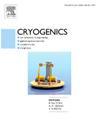Multi-parametrical investigation on the start-up of nitrogen pulsating heat pipes for space applications
IF 2.1
3区 工程技术
Q3 PHYSICS, APPLIED
引用次数: 0
Abstract
The successful startup of a pulsating heat pipe is crucial for ensuring its stable operation both on ground-based applications and, even more in space conditions. Indeed, under microgravity conditions, the startup behavior of the pulsating heat pipe differs significantly from that observed under normal gravity. Consequently, it is vital to conduct comprehensive research into the startup mechanisms of the pulsating heat pipe under zero-gravity conditions. A systematic analysis was conducted on how initial vapor–liquid distribution, filling ratio, assembly parameter, and thermal load influence the startup characteristics of nitrogen PHPs by ground-based horizontal experiments. The results showed that initial vapor–liquid distribution was key in determining startup success. Precooling and filling in the horizontal orientation inevitably led to startup failure. In contrast, performing precooling and filling in the vertical orientation or modifying the initial vapor–liquid distribution by heating the condenser facilitated the startup of the pulsating heat pipe in the horizontal orientation. With a 20% filling ratio, the PHPs could successfully start up and operate across a broad thermal load range, ensuring efficient heat transfer. With a 40% filling ratio, periodic flow stagnation tended to occur inside the PHPs. With a 60% filling ratio, the PHPs struggled to start successfully. Even when startup occurred, its operational thermal load range for efficient heat transfer was limited. Moreover, increasing the number of turns has helped to minimize fluctuations in the evaporator temperature and PHP pressure during operation. A double-loop configuration has also greatly enhanced the temperature uniformity of the evaporator. Among the three configurations, the single-loop 12-turn PHP exhibited the optimal heat transfer performance at a 20% filling ratio.
空间用氮气脉动热管启动的多参数研究
脉动热管的成功启动对于确保其在地面应用甚至空间条件下的稳定运行至关重要。事实上,在微重力条件下,脉动热管的启动行为与正常重力下观察到的有很大不同。因此,对脉动热管在零重力条件下的启动机理进行全面研究具有重要意义。通过地面水平试验,系统分析了初始气液分布、填充比、装配参数和热负荷对氮气php启动特性的影响。结果表明,初始汽液分布是决定启动成功与否的关键。在水平方向预冷和填充不可避免地导致启动失败。相反,在垂直方向进行预冷和填充或通过加热冷凝器来改变初始汽液分布有利于在水平方向上启动脉动热管。在填充率为20%的情况下,php可以成功启动并在很宽的热负荷范围内运行,确保高效的传热。当填充率为40%时,PHPs内部会出现周期性的流动停滞。由于填充率为60%,php很难成功启动。即使在启动时,其有效传热的运行热负荷范围也是有限的。此外,增加旋转次数有助于减少运行期间蒸发器温度和PHP压力的波动。双回路配置也大大提高了蒸发器的温度均匀性。其中,填充率为20%时,单回路12转PHP的换热性能最佳。
本文章由计算机程序翻译,如有差异,请以英文原文为准。
求助全文
约1分钟内获得全文
求助全文
来源期刊

Cryogenics
物理-热力学
CiteScore
3.80
自引率
9.50%
发文量
0
审稿时长
2.1 months
期刊介绍:
Cryogenics is the world''s leading journal focusing on all aspects of cryoengineering and cryogenics. Papers published in Cryogenics cover a wide variety of subjects in low temperature engineering and research. Among the areas covered are:
- Applications of superconductivity: magnets, electronics, devices
- Superconductors and their properties
- Properties of materials: metals, alloys, composites, polymers, insulations
- New applications of cryogenic technology to processes, devices, machinery
- Refrigeration and liquefaction technology
- Thermodynamics
- Fluid properties and fluid mechanics
- Heat transfer
- Thermometry and measurement science
- Cryogenics in medicine
- Cryoelectronics
 求助内容:
求助内容: 应助结果提醒方式:
应助结果提醒方式:


